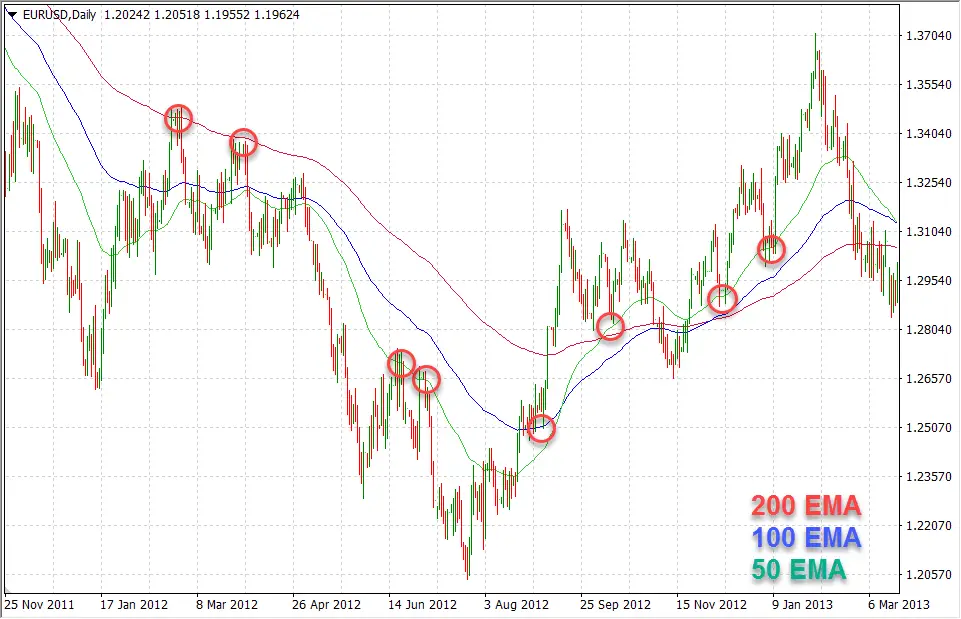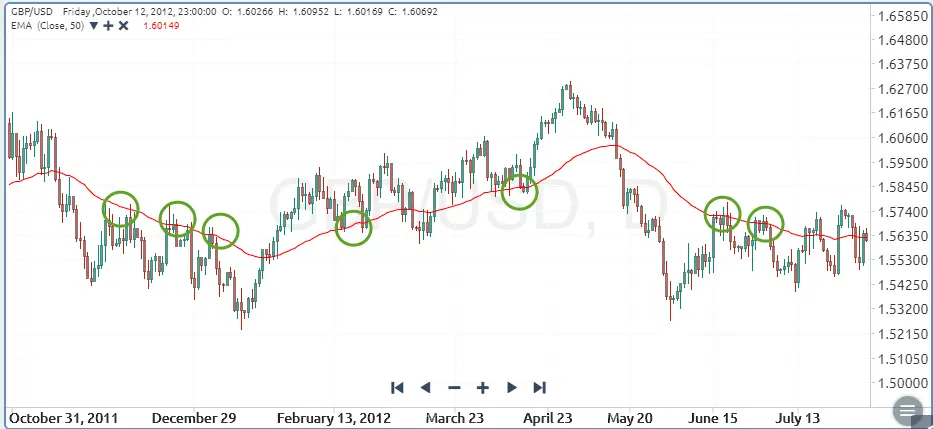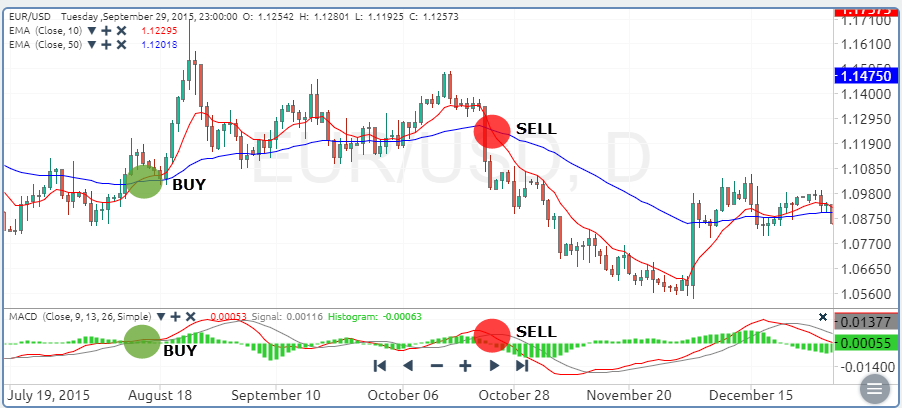Some of the first technical indicators or trading tools in general that new traders encounter are moving averages, and there is a simple explanation for this: MAs are extremely powerful.
Moving averages can be used in a variety of setups, from trend-following to counter-trend trading, and can be effectively combined with other technical indicators if necessary.
Here are the best ways to use moving averages to find trading opportunities and to improve your overall success rate in trading.
MAs Explained
Moving averages are an extremely popular technical indicator, used among hundreds of thousands of traders around the world. Whether you’re trading forex, stocks, or commodities, you’ve likely encountered plenty of trading strategies that rely on moving averages. Even if you’re a fundamental trader, chances are that you’re using moving averages, in one way or another, to identify suitable entry and exit points for your trades.
This is exactly the purpose of this article. To show you how to use moving averages to find better and safer trading opportunities in the markets. There is a number of options you have at your disposal, and we’ll go through the most effective of them.
Moving averages, or MAs for short, are indicators that calculate the average price of a pre-specified number of trading periods and plot that price on a chart.
For example, if you apply a 20-period moving average to a 1-hour chart, you’ll see the average price of the last 20 hourly candlesticks on your chart. As a new hourly candle forms on the chart, the last (21st) candle gets excluded from the calculation, and the latest candlestick gets included in the calculation. That’s what the “moving” part of MAs means.
Types of MAs
The two most popular types of moving averages are simple moving averages (SMAs) and exponential moving averages (EMAs). Simple moving averages take the simple, arithmetic mean in the calculation of the average price, while exponential moving averages take the geometric mean to get to the average price.
Naturally, this means that EMAs are quicker in responding to the latest price-changes than SMAs, which makes them an obvious choice for shorter-term traders.
Besides SMAs and EMAs, there is a handful of other MA types that are not as widely used as the aforementioned ones. They include the ALMA, the Hull MA, and the Zero-Lag MA, to mention some of them.
Another popular type of MAs is the weighted moving average (WMA). As its name suggests, the WMA applies weight to each of the last n-period candlesticks, which allows traders to emphasize the prices they consider important (first prices, last prices, prices in the middle, etc.).
Why Should You Use MAs in Your Trading?
Since MAs are so popular among forex traders, they have a characteristic of self-fulfilling prophecy. For example, if the price approaches the 200-day SMA (an important MA on the daily chart), traders will start to front-run other traders by placing trades around the MA, which in turn can impact the price and even lead to a reversal.
Given the importance of MAs, there is no question that you can improve your trading performance by applying MAs to your trading strategy. Here a few examples of how to find safer trading opportunities by using moving averages.
Trading with Dynamic MAs
Moving averages often act as dynamic support and resistance levels for the price. They are called dynamic because the support and resistance levels move with the price and dynamically re-calculate their levels.
Popular settings for dynamic MAs include the 50-day MA, the 100-day MA, and the 200-day MA. However, traders can also apply the same period-settings to shorter-term charts, like the 1-hour or even 5-minutes one.
Here is a chart with the 200-day, 100-day, and 50-day EMAs applied to the EUR/USD pair. Take a look at the behavior of the price around those moving averages. Also, note the very strong support and resistance that the 200-day EMA formed in the pair.

Why do dynamic moving average S&R levels work? The reason is simple: a large number of traders are placing their orders near import MA levels. As the price approaches the MA, the orders get executed and create significant buying or selling pressure, which can move the price.
Similarly, many traders place their stop-loss levels around MAs. As stop-losses get executed, those traders have to cover their positions which creates additional trading volume in the direction of the breakout. This is why you’ll often see strong bullish or bearish candlesticks when an important MA breaks, such as the 200-day MA.

The chart above shows how the GBP/USD pair behaved around the 50-day exponential moving average. Notice that the pair found support or resistance around the MA more often than not.
Identifying Trends with MAs
Moving averages are also often used to identify the underlying trend in the markets. A popular technique is to measure the slope of the moving averages: A rising slope signals an uptrend, while a falling slope signals a downtrend.
Popular period-settings for this approach include the 21-day and 100-day MAs. The short-term MA (21-day) is the first to react to changes in the trend, while the 100-day MA acts as a filter. Only when the 100-day MA starts to follow the 21-day MA can we say that a trend has been established.
Unfortunately, since moving averages are lagging the price, traders may miss a large part of the profits before both MAs send a trading signal. To overcome this drawback, you may add a third short-term MA with a period-setting of 9.
When the 9-day period crosses above the 21-day MA, and the 21-day MA crosses above the 100-day MA, this is an early warning sign that a new trend is forming. Aggressive traders can jump in the market as soon as the first signal (the 9-day/21-day cross) forms.

Risk-averse traders should stick to the first approach: Wait for both the 21-day and 100-day MAs to turn in the same direction before initiating a new trading position. While this may lead to some missed profits, the advantage is that the underlying trend will be stronger and more established, which will ultimately lead to a higher success rate.
Trading Pullbacks with MAs
Moving averages can also be used to trade pullbacks in the markets. Pullbacks, or market corrections, are shorter-term moves that go against the direction of an established trend. For example, in an uptrend, a pullback would lead to lower prices. But in a downtrend, a pullback would lead to higher prices.
Pullbacks form for a number of reasons. Overextended markets often correct part of their moves because of profit-taking activities, or because of buyers and sellers who find the current price attractive to take a counter-trend trade.
Whatever the reason behind a pullback, here is how to trade it with moving averages. Add two MAs to your chart, one longer-term (e.g. the 50-day MA) and one very short-term (e.g. the 9-day MA). When the shorter-term MA reverses in the opposite direction of the longer-term MA, we have a correction in the market.
For example, when the 50-day MA slopes upwards but the 9-day MA starts to reverse the direction and slopes downwards, we have a correction during an uptrend. Similarly, when the 50-day MA slopes downwards but the 9-day MA starts to slope upwards, we have a correction during a downtrend.

It’s important to note that trading pullbacks can be quite risky, as we are establishing a position in the opposite direction of the underlying trend. That’s why it’s a good idea to take advantage of dynamic MAs to find support and resistance levels, which in turn can be used to enter into a trade in the direction of the underlying trend (i.e. trend-following.)
Here is an example of how this would work. Let’s say the 50-day MA is sloping upwards, signaling an uptrend. The 9-day MA starts to reverse and slopes downwards, signaling a correction during an uptrend. To initiate a buying position (because we want to trade in the direction of the underlying trend), we could use the 50-day, 100-day, or even 200-day MAs and place a Buy Limit (pending order) near them.
As the price approaches the 50-day MA, there is a high chance that the market will consider that MA as a support level, especially during an uptrend.
MA Crossovers
MA crossovers have been around for decades and are likely one of the first trading strategies that new traders encounter. An MA crossover is simply a trading signal based on a faster moving average crossing over a slower moving average (faster MAs are those with shorter period-settings, which allows them to react quicker to price changes.)
Given its simplicity, does a trading strategy based on MA crossovers actually work? A common problem with widespread trading strategies is that they lose their edge as more and more traders start to trade on them. In other words, the price reacts quicker to an MA crossover, eliminating most of the short-term profit opportunities.
However, what if we could tweak a simple MA crossover to return a better trading performance? Let’s find out.
This strategy is based on using MA crossovers to find entry levels for trades that go in the direction of the underlying trend. In addition, in order to increase the overall profit opportunity, we’ll look to trade after the market completes a pullback.
For this strategy, we are going to use the 50-day MA that shows us the direction of the underlying trend, the 21-day MA as an intermediate MA, and the 9-day MA as a signal MA.
Once we identify a pullback (using the rules mentioned previously), we’ll be looking for the 9-day MA to cross over the 21-day MA. When the signal MA (9-day) crosses the intermediate MA, we have a strong signal that bulls (or bears if the market is in an overall downtrend) are taking over control and that the pullback is likely finished.
Here is how this looks like on the chart, using the same pair as before.

Trading MAs with Technical Confirmation
Last but not least, this point will show you how to use MAs in combination with other popular technical indicators, such as Stochastics and MACD. Since MAs are a trend-following indicator, combining them with indicators of other types, such as oscillators, can offer powerful signals when trading the markets.
Oscillators are often used to identify overbought and oversold market conditions. These conditions often occur when markets form pullbacks, which means that we can use the power of MAs (as dynamic support and resistance levels, for example) together with oscillating indicators to find suitable entry points in the markets.

The chart above shows a setup that uses Exponential Moving Averages (10-period is red, 50-period is blue) combined with the MACD indicator. The MACD indicator is often considered both an oscillator and a trend-following indicator.
Since MACD is based on MAs, its underlying nature is by definition trend-following. But, the MACD histogram provides the oscillating part of the indicator.
The trading is simple: We buy when the fast MA crosses above the slow MA, and when the MACD histogram turns from negative to positive. Similarly, we sell when the fast MA crosses below the slow MA, and the MACD histogram turns from positive to negative.
Final Words
Moving averages are an extremely popular technical indicator that is used by thousands of traders around the world.
Although it is a trend-following indicator, we can use it in a large variety of setups: to identify and confirm current trends, to measure pullbacks and identify when they end, to find dynamic support and resistance levels, and to spot changes in momentum (as two MAs cross from above or below), to name a few.
Although moving averages are widely used by traders, it’s a good idea to use some other technical tools to confirm a trading signal before entering into a trade. Candlestick patterns, chart patterns, or even other technical indicators (such as the MACD) can be used to increase the success rate when trading with moving averages.

